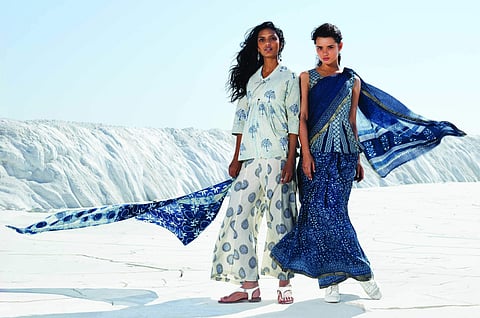
- LIFESTYLE
- FASHION
- FOOD
- ENTERTAINMENT
- EVENTS
- CULTURE
- VIDEOS
- WEB STORIES
- GALLERIES
- GADGETS
- CAR & BIKE
- SOCIETY
- TRAVEL
- NORTH EAST
- INDULGE CONNECT

Jaipur may be the hub for culture, history and shopping but our short visit there led us to a little, unassuming village called Bagru, about 35 kilometres away from the capital city of Rajasthan. A 45-minute drive on National Highway 48 later, we find ourselves winding through narrow dusty roads, flanked by huts and past stray animals languishing in the summer heat. Bagru is renowned for its block prints, usually done with natural dyes made from materials like iron, tree gum, indigo and myrobalan. We finally come to a stop at a large property, with three different spaces, dedicated Bagru and Dabu printing, and indigo dyeing.
The unit is busy with local artisans labouring over yards and yards of fabric. The walls are stacked high with wooden block prints, some over 100 years old, with designs so intricate and varied that they’re hard to replicate. This is the indigo dyeing and block-printing centre run by Ram Kishore Derawala, a Padma Shri awardee, recognised for his efforts towards bringing the Indian crafts to the fore. We are first shown how Bagru printing is done. The cloth is washed and soaked for a day, to remove impurities, oils and other stains, before being dyed in a solution made with harda (extracted from Myrobalan fruit). The solution ensures that the dyes stick to the cloth and gives the fabric a yellow tinge. After being left to dry in the open, the fabric is ready to be printed on. In the workshop, the cloth is neatly laid out on long tables as the artisans dip their blocks — gadh (background), rehk (sharp outline) and daata (filler design) into natural dyes to create the desired prints.
We are shown a dizzyingly complicated design that won the centre a national award. Once the printing is done, the fabric is washed, three days later. Then, the dry cloth is boiled in a large copper vat with natural ingredients like tree gum and dawoodia flowers. This is followed up with another round of washing and drying. Then it is finally ready to be sold.
Dabu printing, a mud resist dyeing technique is done in the building adjacent to our first stop. Here, blocks are dipped into a mixture made with clay, lime, wheat chaff and gum, and pressed onto the fabric. The sticky mixture clings to the cloth. This is then covered with sawdust to ensure that when it is dipped in dye later on, the colour doesn’t run into the block printed design. Once the clay mixture has completely dried, the cloth is soaked in vats of colour. We are shown how it is done. A recently printed piece of fabric is skillfully dipped in a nine-foot deep indigo vat, set into the floor of one of the rooms. It is then laid out in the sun. It is quite magical to see a deep green shade turn blue right before our eyes as the cloth comes in contact with air. The more intense the sunlight, the deeper the shade of blue gets, we are told. The centre works with Kota cotton and silk, Chanderi cotton and silk, khadi and cotton from Andhra, Tamil Nadu and beyond.
After stocking up on dupattas, saris and yardage sold at their in-house store, we are back on the road, on our way to a village called Jhak, where the Gujarati Ajrakh printing is done. The landscape, barren and brown with pops of green, men in their large, bright turbans and women in their vibrant outfits, is almost poetic and feels like a scene right out of a film. Fifteen minutes later, we pull up in front of a house, which belongs to an artisan called Prahlad. The first floor is his studio and the ground floor is where he lives, with his wife and kids. This is the only place in the area that specialises in this form of block printing, in which treated fabric is printed on and then brushed with colour, instead of being dipped, and then dried. The workshop provides employment to women in neighbouring areas and we find a group of them working hard, as they carefully brush a cheerful yellow dye over cotton fabrics and put them out in the sun.
Both Prahlad and Ram work with Fabindia, as part of their initiative to celebrate Indian crafts and provide livelihood to local artisans.
The writer visited Bagru and Jhak on invitation by Fabindia ahead of the launch of their Indigo Collection.